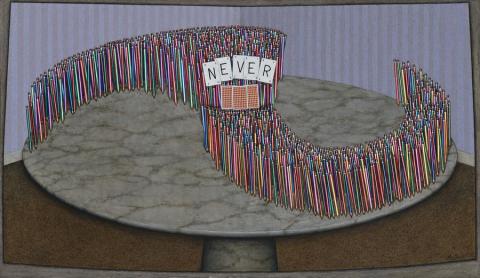NEVER, 1989-90
JOHN BRACK
oil on canvas
106.0 x 182.5 cm
signed and dated lower right: John Brack 89/90
Private collection, Melbourne
A Question of Balance: John Brack 1974 – 1994, Heide Museum of Modern Art, Melbourne, 1 April – 28 May 2000
Blue Chip XIII, Niagara Galleries, Melbourne, 8 March – 2 April 2011 (label attached verso)
Millar, R., 'Brack deals stunning cards', Herald, Melbourne, 24 October 1989 (illus.)
Grishin, S., The Art of John Brack, Oxford University Press, Melbourne, 1990, vol. II, cat. o311, p. 40, p. 187 (illus.)
Gott, T., A Question of Balance: John Brack 1974 – 1994, Heide Museum of Modern Art, Melbourne, 2000, p. 33 (illus.)
'John was not an artist who was concerned with immediacy, spontaneity, facility or aesthetics. He was concerned with meaning and with structures that could sustain and develop this, making each work specifically and deliberately, by calculation and attention.'1
By the late 1970s John Brack turned his vivisector gaze inward as he sought out new ways to express his endless fascination with mankind's social arrangements and interactions. He found a deceptively simple solution among the perfectly ordered pencils and ink pens in his studio and these tools of trade became a metaphor of conformism and society itself. When arranged in groups and viewed from the perspective of Brack's tightly formed compositions these bands of pencils and pens formed opposing armies marching to battle or on the cusp of conflict. As Ted Gott reiterates,'the 'pencil and pen' paintings and watercolours further reflect Brack's pondering upon humanity's perpetual disputes overterritory...'2 Never painted in 1989-90 also employs the device of vintage alphabet playing cards, which Brack would assemble with great dexterity into elaborate card houses in his studio. The army of pencils advancing from the rear of the marble table brandish the words of defiance, 'NEVER', while we are left to guess at the three letters held up by the opposing forces, the most obvious interpretation being the word 'NOW'. Brack has created an ambiguous standoff, the dramatic point before physical force will prevail and the dying moments where language alone may either stave off warfare or provoke it. As Helen Brack explains, Never is an all encompassing concept manifest in the entire battle paintings. In the case of this particular example,'It is NEVER give up; it is Continuation, that Humanity will continue - in whatever manner? On the back edge of the table, where those three leading pencils are leaving the NOW, there is a space, a sort of gateway against which the wallpaper stripes stream upwards, and the section that starts with the three cards and ends with the single pencil is a perfect half-circle.'3
As Gott notes, 'Brack's many 'battle' compositions also consider the groups which are inexorably connected to the rules of society, as well as the tribal arrangements to which we all unintentionally adhere. Within this overarching view of the world struggle, whichsimultaneously destroys and advances particular branches of civilisation, John Brack'spaintings of the 1980s also explore numerous sub-themes such as the ironic duality of society's simultaneous need for and subversion of hierarchical structure - the confluent election to office and relentless plotting against kings, queens and ministers, for example.The allegorical reading of many of these pictures is simple enough " We are taken over by Them, and pushed out; but then Them becomes Us, as we realise we are all the same; and this cycle of aggression, colonisation and assimilation is perpetual. Within this basic genus of conflict, across a decade of creative engagement, Brack's battle compositions explored the realms of human interaction and confrontation with permutations and perverse subtleties as endless as the relentless course of history itself.'4 Never is a critical example among this group of works. The Battle of 1980/83 (National Gallery of Australia, Canberra) was a panoramic distillation of the concept. Brack began to incorporate the alphabet playing cards at around that time and they were used to great effect in Yes, No (Bendigo Art Gallery, Victoria) and again with powerful resolve in The Pros and Cons 1985 (National Gallery of Australia). The notion of historic continuum and the contradictions between civilisation and the brutality and bloodshed of war alluded to by Helen Brack become strikingly evident in The Hunt 1988 (Geelong Art Gallery, Victoria) and again in Kings and Queens (private collection) also painted that year.
Never is an ambitious summation of this important mature group of works by Brack. As Helen Brack comments, 'one of the assets of a picture is, as in opera, that incompatible meanings can coexist; multiple meanings, as the cubists practised. One intriguing illusion in this picture is that all the pencils are the same size, both back ones and front ones, but it looks as if the back ones are bigger. We look up at the back pencils, but down upon the front ones. The floor of the table, another creature-like shape as it oozes flatly around, identifies the animal shape of NEVER, and is in contrast with the semi-circular cove of the other side of the table. Human savagery and civilisation, both present.'5
1. Gott, T., A Question of Balance: John Brack 1974-1994, Heide Museum of Modern Art, Melbourne, 2000, p. 14
2. Ibid., p. 13
3. Maudsley, H., Blue Chip XIII, Niagara Galleries, Richmond, 2011, p. 4
4. Gott, op. cit., pp. 13-14
5. Maudsley, op. cit., p. 4
LARA NICHOLLS
